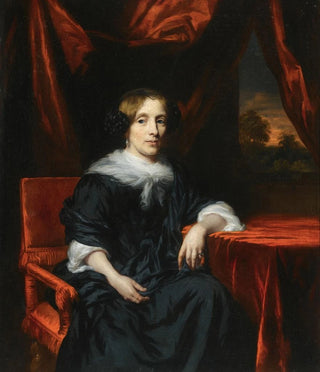Art print | Portrait of a lady in a black dress - Nicolaes Maes


View from behind

Frame (optional)
Portrait of a Lady in a Black Dress - Nicolaes Maes – Captivating Introduction
The "Portrait of a Lady in a Black Dress" by Nicolaes Maes is a work that transcends the simple frame of a portrait to offer an immersion into the intimacy of a bygone era. Created in the 17th century, this emblematic piece of Dutch Baroque art showcases the artist's virtuosity and his ability to capture the psychology of his subjects. The woman depicted, both mysterious and elegant, seems to invite us to share a suspended moment in time. This painting, both understated and emotionally charged, prompts us to question the identity and social status of its model, while immersing us in the subdued atmosphere of bourgeois salons of the period.
Style and uniqueness of the work
Nicolaes Maes's style is distinguished by his ability to combine realism and sensitivity. In the "Portrait of a Lady in a Black Dress," the meticulous details of the dress, the texture of the fabrics, and the play of light on the woman's face reveal exceptional craftsmanship. The artist uses delicate shadows to shape the features of his model, thus emphasizing her contemplative expression. The color palette, dominated by dark tones, evokes an emotional depth that contrasts with the brightness of the face. This chromatic choice helps create an atmosphere that is both mysterious and captivating, where the viewer's gaze is irresistibly drawn to the lady's eyes. The neutral background, meanwhile, highlights the silhouette and allows focus on the facial and dress details, making this work a perfect example of mastery in portraiture in the 17th century.
The artist and his influence
Nicolaes Maes, born in 1634 in Dordrecht, is one of Rembrandt's most talented students. His work is marked by his master's influence, but he developed a style that is uniquely his own. Specializing in portraiture, he contributed to redefining the conventions of this artistic genre. Maes does not merely reproduce the appearance of his subjects; he seeks to capture their essence, character, and to tell a story through their image. His innovative approach paved the way for

Matte finish

View from behind

Frame (optional)
Portrait of a Lady in a Black Dress - Nicolaes Maes – Captivating Introduction
The "Portrait of a Lady in a Black Dress" by Nicolaes Maes is a work that transcends the simple frame of a portrait to offer an immersion into the intimacy of a bygone era. Created in the 17th century, this emblematic piece of Dutch Baroque art showcases the artist's virtuosity and his ability to capture the psychology of his subjects. The woman depicted, both mysterious and elegant, seems to invite us to share a suspended moment in time. This painting, both understated and emotionally charged, prompts us to question the identity and social status of its model, while immersing us in the subdued atmosphere of bourgeois salons of the period.
Style and uniqueness of the work
Nicolaes Maes's style is distinguished by his ability to combine realism and sensitivity. In the "Portrait of a Lady in a Black Dress," the meticulous details of the dress, the texture of the fabrics, and the play of light on the woman's face reveal exceptional craftsmanship. The artist uses delicate shadows to shape the features of his model, thus emphasizing her contemplative expression. The color palette, dominated by dark tones, evokes an emotional depth that contrasts with the brightness of the face. This chromatic choice helps create an atmosphere that is both mysterious and captivating, where the viewer's gaze is irresistibly drawn to the lady's eyes. The neutral background, meanwhile, highlights the silhouette and allows focus on the facial and dress details, making this work a perfect example of mastery in portraiture in the 17th century.
The artist and his influence
Nicolaes Maes, born in 1634 in Dordrecht, is one of Rembrandt's most talented students. His work is marked by his master's influence, but he developed a style that is uniquely his own. Specializing in portraiture, he contributed to redefining the conventions of this artistic genre. Maes does not merely reproduce the appearance of his subjects; he seeks to capture their essence, character, and to tell a story through their image. His innovative approach paved the way for






